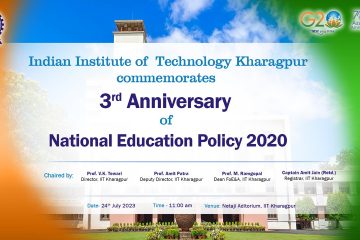The researchers use Atomic Force Microscope to directly observe the width and the physical nature of grain boundary domains in rocks on the nanoscale for the first time and this study is among very few in the world that have applied this technique to geological samples, and the first of its kind in India.
In a recent study, a team of researchers led by Prof Saibal Gupta, Professor of Geology and Geophysics Department and Prof Rabibrata Mukherjee, Professor of Chemical Engineering Department along with the research scholars Ritabrata Dobe and Anuja Das from the Department of Geology & Geophysics and Chemical Engineering respectively, for the first time, have corroborated that systematic changes in grain boundary morphology in quartzite samples metamorphosed at different metamorphic grades can be directly visualized using Atomic Force Microscopy (AFM) which allows comparatively easy, high magnification imaging and precise width measurements. The research has been published in the reputed journal Scientific Reports, published by Nature publishing group.
“The results of the study show that quartzites deformed and metamorphosed at lower grades have wider grain boundaries with voids along the channels and at triple junctions and a much lower proportion of bridges compared to those that are deformed at higher grades. The latter have narrower channels, no voids along these channels, and an abundance of periodically arranged bridges oriented at right angles to the length of the boundary”, said Prof Gupta. “This study also reveals that grain boundary character changes with metamorphic temperature, thereby controlling the extent of water percolation through quartz-bearing rock in the Earth’s crust at depth”.
Prof. Gupta and his Ph.D. student Ritabrata Dobe were grappling with a problem that has fascinated geologists for some time – what makes water percolate more easily through some rocks in the Earth’s continental crust compared to others? Hydrous fluids play a vital role in the chemical and rheological evolution of ductile, quartz-bearing continental crust, where fluid percolation pathways are controlled by grain boundary domains. They took a cue from studies conducted in the metallurgical and material sciences, where it is well known that fluid percolation leads to corrosion or cracking; to circumvent these effects, attempts are made to impart certain beneficial characteristics to the grain boundary network. They decided to try out this idea on natural quartz-rich rocks.
“We suggest that the strength of grain boundary domains is higher in high grade metamorphic rocks compared to lower metamorphic grade rocks, and together with the other grain boundary features, contribute to enhanced resistance to fluid percolation in granulite facies quartzites compared to those metamorphosed under greenschist facies conditions”, said Ritabrata Dobe, Research Scholar working with Prof. Saibal Gupta.
In this study, at the beginning, the researchers have used the standard petrological microscope, and then the Electron Backscatter Diffraction (EBSD) to characterize the grain boundary domains. While EBSD routinely identifies the trace of the boundary on micron-scale, it does not reveal its precise width or morphology. And unless the grain boundaries could be observed at very high magnifications (at nano-scale), they could not actually visualizing what happens. Existing techniques – optical microscopy and EBSD, could not reveal what could happen at those scales.
And so, they decided to talk to Prof. Rabibrata Mukherjee, who is an expert in Atomic Force Microscopy and routinely uses the technique for their work on nano-patterning of soft materials and surfaces at the “Instability and Soft Patterning” laboratory at the Dept. of Chemical Engineering at IIT Kharagpur. His group been using this technique on various systems materials as a part of their research.
“To resolve the geological problem brought to our notice, we decided to use the Atomic Force Microscope (AFM) which is among very few examples of using this highly sophisticated microscopy technique to an earth science related problem. This enables direct nano-scale imaging of the grain boundary – something that cannot be done using any technique other than Transmission Electron Microscopy (TEM), which is a destructive technique- in the sense that thin slices of the samples have to be generated for analysis”, mentioned Prof Rabibrata Mukherjee.
Also, a technique called Force-Distance Spectroscopy has been applied for the first time to the geological samples, to estimate the variations in strength of grain boundary domains and grain interiors within quartzites deformed at different metamorphic conditions.
“The results of FD spectroscopy demonstrate that high grade rocks are in general significantly less deformable compared to low grade rocks. Also, grain boundary domains containing bridges across them are less deformable compared to segments along which bridges are absent. Also, it was extremely interesting to do FD spectroscopy on rock samples, as there was absolutely no literature data”, said Anuja Das, Research Scholar working with Prof. Mukherjee and is already an expert in AFM imaging.
Geologists have been investigating what makes some rocks more or less permeable than others, especially at different depths in the Earth’s crust, where we know that temperature increases with depth from the surface. Thus, the samples on which the experiments were carried out correspond to a range of temperature conditions experienced by rocks in the Earth’s crust. What they found is that rocks that had experienced higher temperatures were less permeable than those heated to lower temperatures. This indicated that water would find it difficult to percolate through hot rocks near the base of the continental crust.
The lead researchers, Prof. Gupta and Prof. Mukherjee, emphasized that “Apart from the scientific problem addressed, the novelty of the study lies in the completely new approach used, and suggest that this may well become a much more widely used technique in future geological studies for revealing various hitherto unknown details at the nano-scale, apart from the structure, morphology and strength of grain boundaries in rocks”. Prof Mukherjee further added “it is a classic example of what collaboration can do, as the individual components of the work were easy and routine for both the groups, but the collective outcome is non-trivial”. Prof Gupta was extremely satisfied to have developed a new technique entirely based on research in-house research at IIT Kharagpur.
Media Contact: Prof Saibal Gupta, Professor, Email: saibl@gg.iitkgp.ac.in, Ph.: +91- 3222- 283370
(Inputs from Rituparna Chakraborty, Branding Executive)
For more information Contact: Ms. Paramita Dey, Junior Assistant,
Email: media@iitkgp.ac.in, +91-3222-282004



